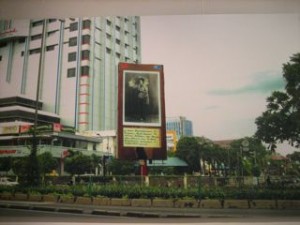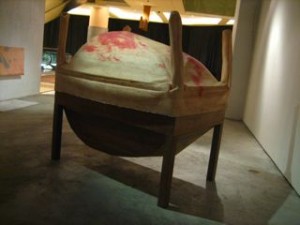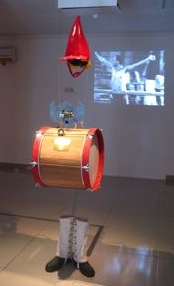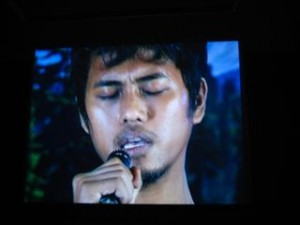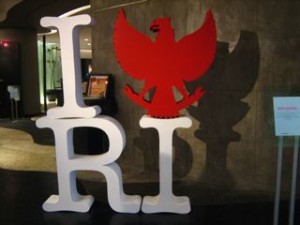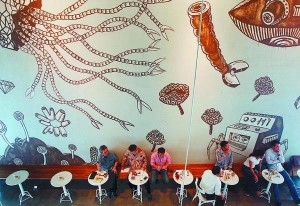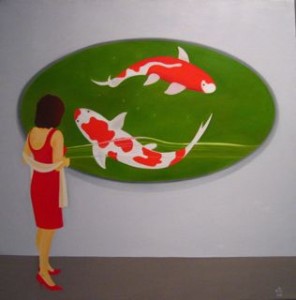Jakarta bisa. Jakarta can. The Jakarta Biennale and our three-day trip to the Indonesian capital proved a real inspiration in these times of cynicism and economic despair.
I thoroughly enjoyed the Biennale in the two leisurely afternoons it took us to cover it. It was, if anything, somewhat short and sweet. Despite severe budget limitations, which have meant that each of its main components have lasted for just a month or less, it was a meaningful experience. With a curatorial team headed by Ruang Rupa co-founder Ade Darmawan, ARE(N)A takes Jakarta, and then Southeast Asia in the world, as its playground, without any grandstanding. I loved both the modesty and clarity of the curatorial approach and the earnestness of its objectives.
A “Zone of Understanding” comprises of outreach projects around the city using dance, performance, children’s art and my favourite idea, “Belles-Lettres in The City” (Jakarta Literary Festival) where poetry, literary and archival news quotations manifest as thought-provoking writing on Jakarta’s walls. In the “Battle Zone”, young Indonesian artists/designers and collectives (who, from their profiles, seem all to double as engineers, musicians, creative directors, film-makers) do their bit with ‘public art’, taking over the streets, billboards, monument, football grounds and train stations; it also included the biennial Jakarta 32 “contest” for art students.
Sadly arriving towards the end of the Biennale meant that we could only catch in person “Fluid Zones”, the central visual art element, which maps Southeast Asian artists under 40 and also works by other international artists made during recent residencies in the region. (We have to declare a vested interest – Adeline is a Networking Curator for this project). Curator Agung Hujatnikajennong from Selasar Sunaryo has pulled together a tight and revealing show spread over the Galeri Nasional and the new mall Grand Indonesia, leading us intuitively through the rough and tumble of Southeast Asian chaos via subtle thematic and strategic resonances. There was no shock-and-awe, and nothing in particular quite blew my mind (also perhaps due to familiarity with many of the artists and some of the works), but the overall sense of engagement, the intimacy and personal commitment of the show as a whole had me sold.
My hot picks would be in no specific order 1) Phil Collins’ ‘Duniatak akan mendengar’ (The World Won’t Listen) with its disturbingly convincing Morrissey would-bes (I almost sang along), 2) Handiwirman Saputra’s visceral wood and rubber installation Exterior, Inside View – Interior, Outside View (you have to not want to touch to understand), 3) Wiyoga Muhardanto’s fleshy objects, especially the nippled handbags of “Buy One Get One Free”, 4) Jompet’s wild feat of electrical engineering “Java’s Machine: Phantasmagoria”, 5) Malaysia’s own Roslisham Ismail (Ise)’s animated story of the legendary warrior Hang Tuah (“HI-S-TORY”) which was hilarious and 6) Craig Walsh’s ‘Incursion’ video in which a live seafood dinner takes over a cafe as it slowly drowns, in a window of the fancy food court of Grand Indonesia.
‘Fluid Zones’ ends on 27 February. A final component of the Biennale, ‘Territories and Boundaries Photo Exhibition’ curated by Farah Wardani, runs from March 29- April 11 at Galeri Cipta III, Taman Ismail Marzuki. Visit www.jakartabiennale.com.
Unlike Rachel in Paris, we actually spent just as much time eating, (drinking) and shopping in Jakarta. Our first stop in fact was the Made-in-Indonesia store Alun Alun where we happed on “Indonesia Hari Ini”, a mini survey of the local creative industry. There were cutting-edge often recycled design samples by initiatives like UNKL347 and Toimoi – we hope they’ll soon appear at Rogue-ish.
We sampled generously the avant-garde cocktails and menu at Potato Head, graced by Eko Nugroho’s mural works, and apparently entirely constructed of found objects, the new brainchild of gallerists Jason Goenawan and Ronald Akili, and chef Sandra. We want one in Kuala Lumpur, but pigs are yet to fly (speaking of which look out for a new feature film by Edwin, Blind Pig Who Wants to Fly, slated for a number of international film festivals this year).
Even as the auction houses reel from the world financial crisis, with Fortune Auction (Borobudur Auction re-invented) holding a no-reserve sale this coming weekend (1 March), the gallery scene seems to be resilient and calendars busy. Curator-turned-artist manager/dealer says it’s business as usual. A new Menteng Art Space is on the horizon. We caught a long-awaited show by Bunga Jeruk at Edwin Gallery in Kemang, and another long-time-coming exhibition, by Yuli Prayitno should be up in the next couple of months, after their big Filipino artists show in collaboration with Valentine Willie Fine Art for which Adeline is moonlighting as Curator.
Outside the commercial gallery scene, the Jendela Group is in Singapore for a major show, A Play of the Ordinary at NUS Museum, curated by Enin Supriyanto. Nearer to home group member Jumaldi Alfi launches a new residency in Yogyakarta for researchers and curators in March.
All this in the midst of election fever in Indonesia. Obviously the Indonesian creative community has long learned to rise above political chaos and economic strife. Come April and the Legislative Elections, we’ll be far more excited about Agus Suwage’s Retrospective held in conjunction with his 50th birthday at Jogja National Museum and his new monograph. (BY)


